https://github.com/ahmedfgad/kerasga
Training Keras Models by the Genetic Algorithm using PyGAD
https://github.com/ahmedfgad/kerasga
convolutional-neural-networks deep-learning genetic-algorithm keras keras-tensorflow machine-learning neural-network numpy pygad python python3
Last synced: 8 months ago
JSON representation
Training Keras Models by the Genetic Algorithm using PyGAD
- Host: GitHub
- URL: https://github.com/ahmedfgad/kerasga
- Owner: ahmedfgad
- Created: 2020-09-20T21:31:44.000Z (about 5 years ago)
- Default Branch: master
- Last Pushed: 2023-06-19T21:50:40.000Z (over 2 years ago)
- Last Synced: 2025-03-29T20:24:02.354Z (9 months ago)
- Topics: convolutional-neural-networks, deep-learning, genetic-algorithm, keras, keras-tensorflow, machine-learning, neural-network, numpy, pygad, python, python3
- Language: Jupyter Notebook
- Homepage: https://pygad.readthedocs.io
- Size: 3.13 MB
- Stars: 36
- Watchers: 3
- Forks: 9
- Open Issues: 2
-
Metadata Files:
- Readme: README.md
- Funding: .github/FUNDING.yml
Awesome Lists containing this project
README
# KerasGA: Training Keras Models using the Genetic Algorithm
[KerasGA](https://github.com/ahmedfgad/KerasGA) is part of the [PyGAD](https://pypi.org/project/pygad) library for training Keras models using the genetic algorithm (GA).
The [KerasGA](https://github.com/ahmedfgad/KerasGA) project has a single module named `kerasga.py` which has a class named `KerasGA` for preparing an initial population of Keras model parameters.
[PyGAD](https://pypi.org/project/pygad) is an open-source Python library for building the genetic algorithm and training machine learning algorithms. Check the library's documentation at [Read The Docs](https://pygad.readthedocs.io/): https://pygad.readthedocs.io
# Donation
- [Credit/Debit Card](https://donate.stripe.com/eVa5kO866elKgM0144): https://donate.stripe.com/eVa5kO866elKgM0144
- [Open Collective](https://opencollective.com/pygad): [opencollective.com/pygad](https://opencollective.com/pygad)
- PayPal: Use either this link: [paypal.me/ahmedfgad](https://paypal.me/ahmedfgad) or the e-mail address ahmed.f.gad@gmail.com
- Interac e-Transfer: Use e-mail address ahmed.f.gad@gmail.com
# Installation
To install [PyGAD](https://pypi.org/project/pygad), simply use pip to download and install the library from [PyPI](https://pypi.org/project/pygad) (Python Package Index). The library lives a PyPI at this page https://pypi.org/project/pygad.
```python
pip3 install pygad
```
To get started with PyGAD, please read the documentation at [Read The Docs](https://pygad.readthedocs.io/) https://pygad.readthedocs.io.
# PyGAD Source Code
The source code of the `PyGAD` modules is found in the following GitHub projects:
- [pygad](https://github.com/ahmedfgad/GeneticAlgorithmPython): (https://github.com/ahmedfgad/GeneticAlgorithmPython)
- [pygad.nn](https://github.com/ahmedfgad/NumPyANN): https://github.com/ahmedfgad/NumPyANN
- [pygad.gann](https://github.com/ahmedfgad/NeuralGenetic): https://github.com/ahmedfgad/NeuralGenetic
- [pygad.cnn](https://github.com/ahmedfgad/NumPyCNN): https://github.com/ahmedfgad/NumPyCNN
- [pygad.gacnn](https://github.com/ahmedfgad/CNNGenetic): https://github.com/ahmedfgad/CNNGenetic
- [pygad.kerasga](https://github.com/ahmedfgad/KerasGA): https://github.com/ahmedfgad/KerasGA
- [pygad.torchga](https://github.com/ahmedfgad/TorchGA): https://github.com/ahmedfgad/TorchGA
The documentation of PyGAD is available at [Read The Docs](https://pygad.readthedocs.io/) https://pygad.readthedocs.io.
# PyGAD Documentation
The documentation of the PyGAD library is available at [Read The Docs](https://pygad.readthedocs.io) at this link: https://pygad.readthedocs.io. It discusses the modules supported by PyGAD, all its classes, methods, attribute, and functions. For each module, a number of examples are given.
If there is an issue using PyGAD, feel free to post at issue in this [GitHub repository](https://github.com/ahmedfgad/GeneticAlgorithmPython) https://github.com/ahmedfgad/GeneticAlgorithmPython or by sending an e-mail to ahmed.f.gad@gmail.com.
If you built a project that uses PyGAD, then please drop an e-mail to ahmed.f.gad@gmail.com with the following information so that your project is included in the documentation.
- Project title
- Brief description
- Preferably, a link that directs the readers to your project
Please check the **Contact Us** section for more contact details.
# Life Cycle of PyGAD
The next figure lists the different stages in the lifecycle of an instance of the `pygad.GA` class. Note that PyGAD stops when either all generations are completed or when the function passed to the `on_generation` parameter returns the string `stop`.
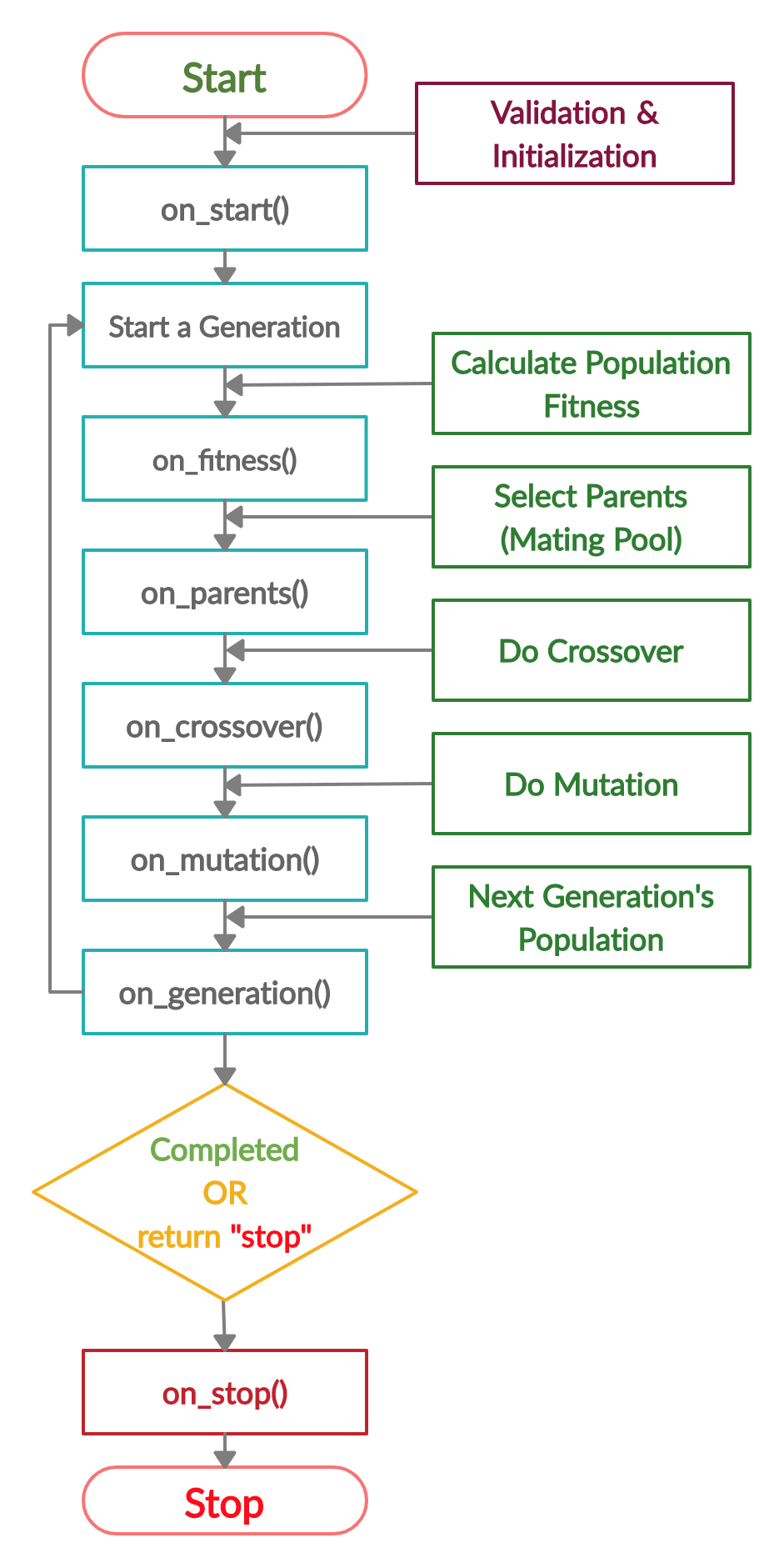
The next code implements all the callback functions to trace the execution of the genetic algorithm. Each callback function prints its name.
```python
import pygad
import numpy
function_inputs = [4,-2,3.5,5,-11,-4.7]
desired_output = 44
def fitness_func(ga_instance, solution, solution_idx):
output = numpy.sum(solution*function_inputs)
fitness = 1.0 / (numpy.abs(output - desired_output) + 0.000001)
return fitness
fitness_function = fitness_func
def on_start(ga_instance):
print("on_start()")
def on_fitness(ga_instance, population_fitness):
print("on_fitness()")
def on_parents(ga_instance, selected_parents):
print("on_parents()")
def on_crossover(ga_instance, offspring_crossover):
print("on_crossover()")
def on_mutation(ga_instance, offspring_mutation):
print("on_mutation()")
def on_generation(ga_instance):
print("on_generation()")
def on_stop(ga_instance, last_population_fitness):
print("on_stop()")
ga_instance = pygad.GA(num_generations=3,
num_parents_mating=5,
fitness_func=fitness_function,
sol_per_pop=10,
num_genes=len(function_inputs),
on_start=on_start,
on_fitness=on_fitness,
on_parents=on_parents,
on_crossover=on_crossover,
on_mutation=on_mutation,
on_generation=on_generation,
on_stop=on_stop)
ga_instance.run()
```
Based on the used 3 generations as assigned to the `num_generations` argument, here is the output.
```
on_start()
on_fitness()
on_parents()
on_crossover()
on_mutation()
on_generation()
on_fitness()
on_parents()
on_crossover()
on_mutation()
on_generation()
on_fitness()
on_parents()
on_crossover()
on_mutation()
on_generation()
on_stop()
```
# Examples
Check the [PyGAD's documentation](https://pygad.readthedocs.io/en/latest/kerasga.html#examples) for more examples information. You can also find more information about the implementation of the examples.
## Example 1: Train Keras Regression Model
```python
import tensorflow.keras
import pygad.kerasga
import numpy
import pygad
def fitness_func(ga_instance, solution, sol_idx):
global data_inputs, data_outputs, keras_ga, model
model_weights_matrix = pygad.kerasga.model_weights_as_matrix(model=model,
weights_vector=solution)
model.set_weights(weights=model_weights_matrix)
predictions = model.predict(data_inputs)
mae = tensorflow.keras.losses.MeanAbsoluteError()
abs_error = mae(data_outputs, predictions).numpy() + 0.00000001
solution_fitness = 1.0/abs_error
return solution_fitness
def callback_generation(ga_instance):
print("Generation = {generation}".format(generation=ga_instance.generations_completed))
print("Fitness = {fitness}".format(fitness=ga_instance.best_solution()[1]))
input_layer = tensorflow.keras.layers.Input(3)
dense_layer1 = tensorflow.keras.layers.Dense(5, activation="relu")(input_layer)
output_layer = tensorflow.keras.layers.Dense(1, activation="linear")(dense_layer1)
model = tensorflow.keras.Model(inputs=input_layer, outputs=output_layer)
keras_ga = pygad.kerasga.KerasGA(model=model,
num_solutions=10)
# Data inputs
data_inputs = numpy.array([[0.02, 0.1, 0.15],
[0.7, 0.6, 0.8],
[1.5, 1.2, 1.7],
[3.2, 2.9, 3.1]])
# Data outputs
data_outputs = numpy.array([[0.1],
[0.6],
[1.3],
[2.5]])
# Prepare the PyGAD parameters. Check the documentation for more information: https://pygad.readthedocs.io/en/latest/pygad.html#pygad-ga-class
num_generations = 250 # Number of generations.
num_parents_mating = 5 # Number of solutions to be selected as parents in the mating pool.
initial_population = keras_ga.population_weights # Initial population of network weights
ga_instance = pygad.GA(num_generations=num_generations,
num_parents_mating=num_parents_mating,
initial_population=initial_population,
fitness_func=fitness_func,
on_generation=callback_generation)
ga_instance.run()
# After the generations complete, some plots are showed that summarize how the outputs/fitness values evolve over generations.
ga_instance.plot_fitness(title="PyGAD & Keras - Iteration vs. Fitness", linewidth=4)
# Returning the details of the best solution.
solution, solution_fitness, solution_idx = ga_instance.best_solution()
print("Fitness value of the best solution = {solution_fitness}".format(solution_fitness=solution_fitness))
print("Index of the best solution : {solution_idx}".format(solution_idx=solution_idx))
# Fetch the parameters of the best solution.
best_solution_weights = pygad.kerasga.model_weights_as_matrix(model=model,
weights_vector=solution)
model.set_weights(best_solution_weights)
predictions = model.predict(data_inputs)
print("Predictions : \n", predictions)
mae = tensorflow.keras.losses.MeanAbsoluteError()
abs_error = mae(data_outputs, predictions).numpy()
print("Absolute Error : ", abs_error)
```
## Example 2: XOR Binary Classification
```python
import tensorflow.keras
import pygad.kerasga
import numpy
import pygad
def fitness_func(ga_instance, solution, sol_idx):
global data_inputs, data_outputs, keras_ga, model
model_weights_matrix = pygad.kerasga.model_weights_as_matrix(model=model,
weights_vector=solution)
model.set_weights(weights=model_weights_matrix)
predictions = model.predict(data_inputs)
bce = tensorflow.keras.losses.BinaryCrossentropy()
solution_fitness = 1.0 / (bce(data_outputs, predictions).numpy() + 0.00000001)
return solution_fitness
def callback_generation(ga_instance):
print("Generation = {generation}".format(generation=ga_instance.generations_completed))
print("Fitness = {fitness}".format(fitness=ga_instance.best_solution()[1]))
# Build the keras model using the functional API.
input_layer = tensorflow.keras.layers.Input(2)
dense_layer = tensorflow.keras.layers.Dense(4, activation="relu")(input_layer)
output_layer = tensorflow.keras.layers.Dense(2, activation="softmax")(dense_layer)
model = tensorflow.keras.Model(inputs=input_layer, outputs=output_layer)
# Create an instance of the pygad.kerasga.KerasGA class to build the initial population.
keras_ga = pygad.kerasga.KerasGA(model=model,
num_solutions=10)
# XOR problem inputs
data_inputs = numpy.array([[0, 0],
[0, 1],
[1, 0],
[1, 1]])
# XOR problem outputs
data_outputs = numpy.array([[1, 0],
[0, 1],
[0, 1],
[1, 0]])
# Prepare the PyGAD parameters. Check the documentation for more information: https://pygad.readthedocs.io/en/latest/pygad.html#pygad-ga-class
num_generations = 250 # Number of generations.
num_parents_mating = 5 # Number of solutions to be selected as parents in the mating pool.
initial_population = keras_ga.population_weights # Initial population of network weights.
# Create an instance of the pygad.GA class
ga_instance = pygad.GA(num_generations=num_generations,
num_parents_mating=num_parents_mating,
initial_population=initial_population,
fitness_func=fitness_func,
on_generation=callback_generation)
# Start the genetic algorithm evolution.
ga_instance.run()
# After the generations complete, some plots are showed that summarize how the outputs/fitness values evolve over generations.
ga_instance.plot_fitness(title="PyGAD & Keras - Iteration vs. Fitness", linewidth=4)
# Returning the details of the best solution.
solution, solution_fitness, solution_idx = ga_instance.best_solution()
print("Fitness value of the best solution = {solution_fitness}".format(solution_fitness=solution_fitness))
print("Index of the best solution : {solution_idx}".format(solution_idx=solution_idx))
# Fetch the parameters of the best solution.
best_solution_weights = pygad.kerasga.model_weights_as_matrix(model=model,
weights_vector=solution)
model.set_weights(best_solution_weights)
predictions = model.predict(data_inputs)
print("Predictions : \n", predictions)
# Calculate the binary crossentropy for the trained model.
bce = tensorflow.keras.losses.BinaryCrossentropy()
print("Binary Crossentropy : ", bce(data_outputs, predictions).numpy())
# Calculate the classification accuracy for the trained model.
ba = tensorflow.keras.metrics.BinaryAccuracy()
ba.update_state(data_outputs, predictions)
accuracy = ba.result().numpy()
print("Accuracy : ", accuracy)
```
# For More Information
There are different resources that can be used to get started with the building CNN and its Python implementation.
## Tutorial: Implementing Genetic Algorithm in Python
To start with coding the genetic algorithm, you can check the tutorial titled [**Genetic Algorithm Implementation in Python**](https://www.linkedin.com/pulse/genetic-algorithm-implementation-python-ahmed-gad) available at these links:
- [LinkedIn](https://www.linkedin.com/pulse/genetic-algorithm-implementation-python-ahmed-gad)
- [Towards Data Science](https://towardsdatascience.com/genetic-algorithm-implementation-in-python-5ab67bb124a6)
- [KDnuggets](https://www.kdnuggets.com/2018/07/genetic-algorithm-implementation-python.html)
[This tutorial](https://www.linkedin.com/pulse/genetic-algorithm-implementation-python-ahmed-gad) is prepared based on a previous version of the project but it still a good resource to start with coding the genetic algorithm.
[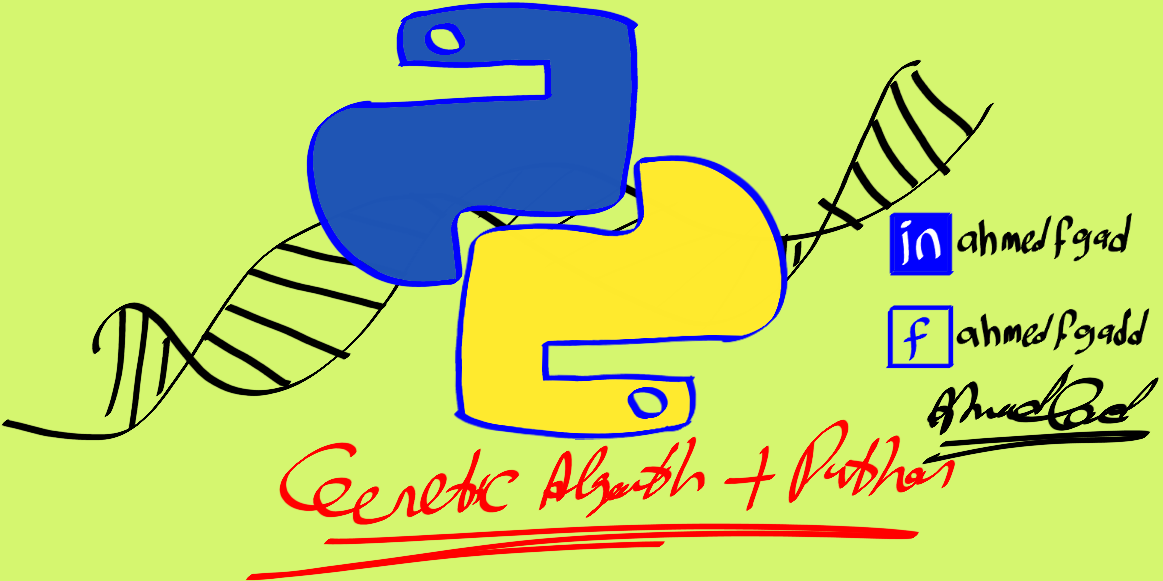](https://www.linkedin.com/pulse/genetic-algorithm-implementation-python-ahmed-gad)
## Tutorial: Introduction to Genetic Algorithm
Get started with the genetic algorithm by reading the tutorial titled [**Introduction to Optimization with Genetic Algorithm**](https://www.linkedin.com/pulse/introduction-optimization-genetic-algorithm-ahmed-gad) which is available at these links:
* [LinkedIn](https://www.linkedin.com/pulse/introduction-optimization-genetic-algorithm-ahmed-gad)
* [Towards Data Science](https://www.kdnuggets.com/2018/03/introduction-optimization-with-genetic-algorithm.html)
* [KDnuggets](https://towardsdatascience.com/introduction-to-optimization-with-genetic-algorithm-2f5001d9964b)
[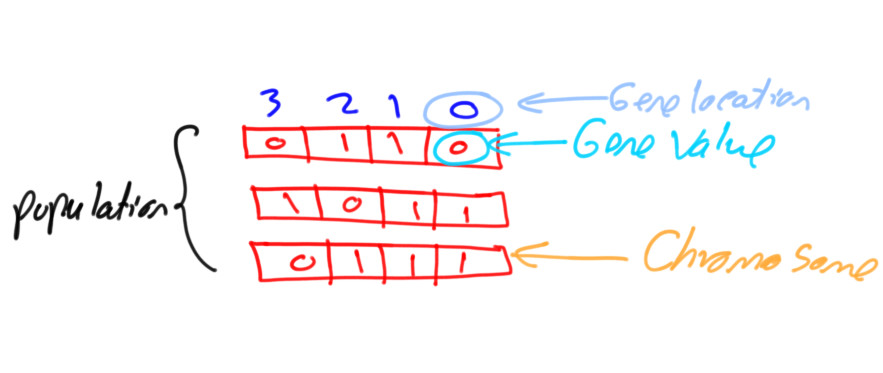](https://www.linkedin.com/pulse/introduction-optimization-genetic-algorithm-ahmed-gad)
## Tutorial: Build Neural Networks in Python
Read about building neural networks in Python through the tutorial titled [**Artificial Neural Network Implementation using NumPy and Classification of the Fruits360 Image Dataset**](https://www.linkedin.com/pulse/artificial-neural-network-implementation-using-numpy-fruits360-gad) available at these links:
* [LinkedIn](https://www.linkedin.com/pulse/artificial-neural-network-implementation-using-numpy-fruits360-gad)
* [Towards Data Science](https://towardsdatascience.com/artificial-neural-network-implementation-using-numpy-and-classification-of-the-fruits360-image-3c56affa4491)
* [KDnuggets](https://www.kdnuggets.com/2019/02/artificial-neural-network-implementation-using-numpy-and-image-classification.html)
[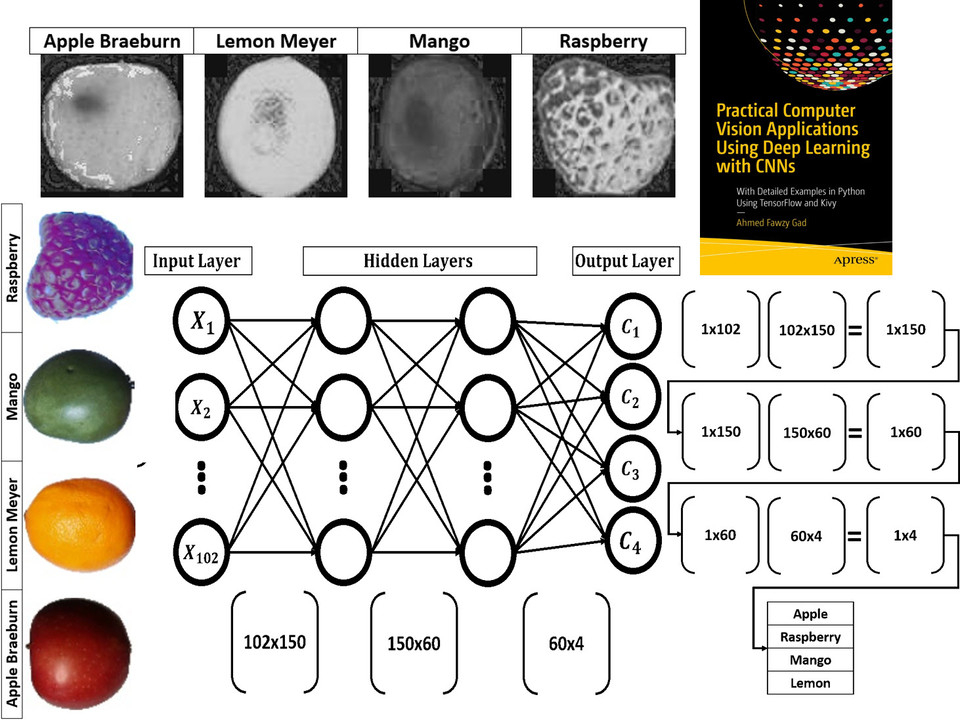](https://www.linkedin.com/pulse/artificial-neural-network-implementation-using-numpy-fruits360-gad)
## Tutorial: Optimize Neural Networks with Genetic Algorithm
Read about training neural networks using the genetic algorithm through the tutorial titled [**Artificial Neural Networks Optimization using Genetic Algorithm with Python**](https://www.linkedin.com/pulse/artificial-neural-networks-optimization-using-genetic-ahmed-gad) available at these links:
- [LinkedIn](https://www.linkedin.com/pulse/artificial-neural-networks-optimization-using-genetic-ahmed-gad)
- [Towards Data Science](https://towardsdatascience.com/artificial-neural-networks-optimization-using-genetic-algorithm-with-python-1fe8ed17733e)
- [KDnuggets](https://www.kdnuggets.com/2019/03/artificial-neural-networks-optimization-genetic-algorithm-python.html)
[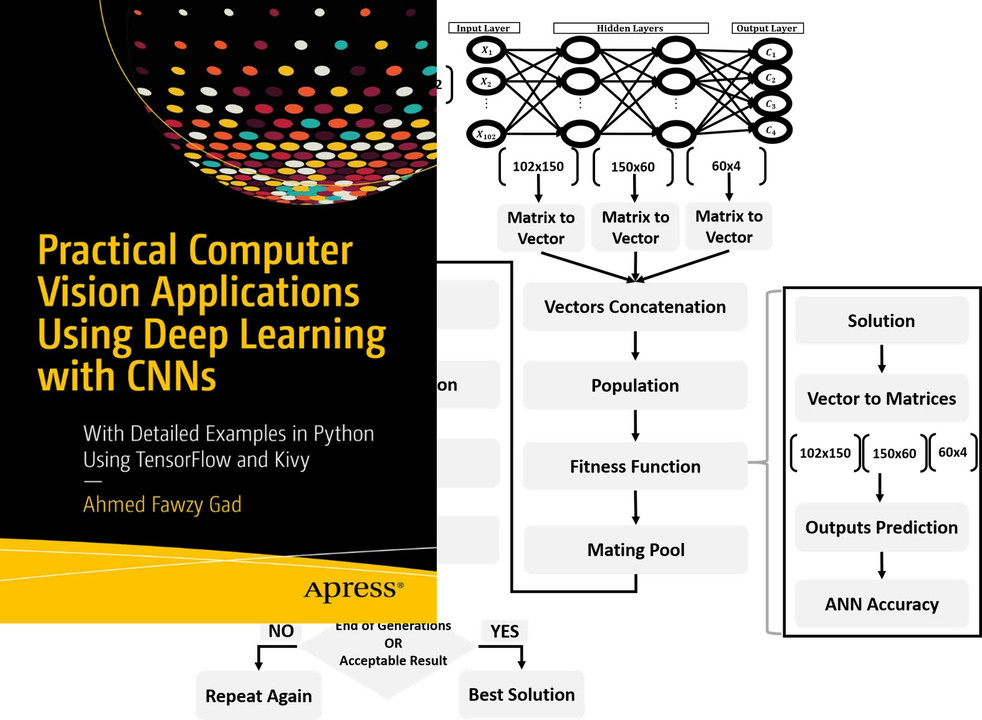](https://www.linkedin.com/pulse/artificial-neural-networks-optimization-using-genetic-ahmed-gad)
## Tutorial: Building CNN in Python
To start with coding the genetic algorithm, you can check the tutorial titled [**Building Convolutional Neural Network using NumPy from Scratch**](https://www.linkedin.com/pulse/building-convolutional-neural-network-using-numpy-from-ahmed-gad) available at these links:
- [LinkedIn](https://www.linkedin.com/pulse/building-convolutional-neural-network-using-numpy-from-ahmed-gad)
- [Towards Data Science](https://towardsdatascience.com/building-convolutional-neural-network-using-numpy-from-scratch-b30aac50e50a)
- [KDnuggets](https://www.kdnuggets.com/2018/04/building-convolutional-neural-network-numpy-scratch.html)
- [Chinese Translation](http://m.aliyun.com/yunqi/articles/585741)
[This tutorial](https://www.linkedin.com/pulse/building-convolutional-neural-network-using-numpy-from-ahmed-gad)) is prepared based on a previous version of the project but it still a good resource to start with coding CNNs.
[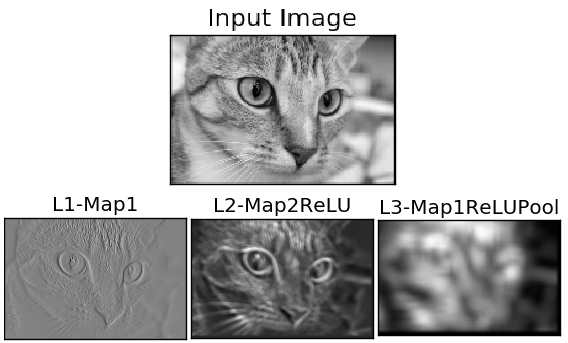](https://www.linkedin.com/pulse/building-convolutional-neural-network-using-numpy-from-ahmed-gad)
## Tutorial: Derivation of CNN from FCNN
Get started with the genetic algorithm by reading the tutorial titled [**Derivation of Convolutional Neural Network from Fully Connected Network Step-By-Step**](https://www.linkedin.com/pulse/derivation-convolutional-neural-network-from-fully-connected-gad) which is available at these links:
* [LinkedIn](https://www.linkedin.com/pulse/derivation-convolutional-neural-network-from-fully-connected-gad)
* [Towards Data Science](https://towardsdatascience.com/derivation-of-convolutional-neural-network-from-fully-connected-network-step-by-step-b42ebafa5275)
* [KDnuggets](https://www.kdnuggets.com/2018/04/derivation-convolutional-neural-network-fully-connected-step-by-step.html)
[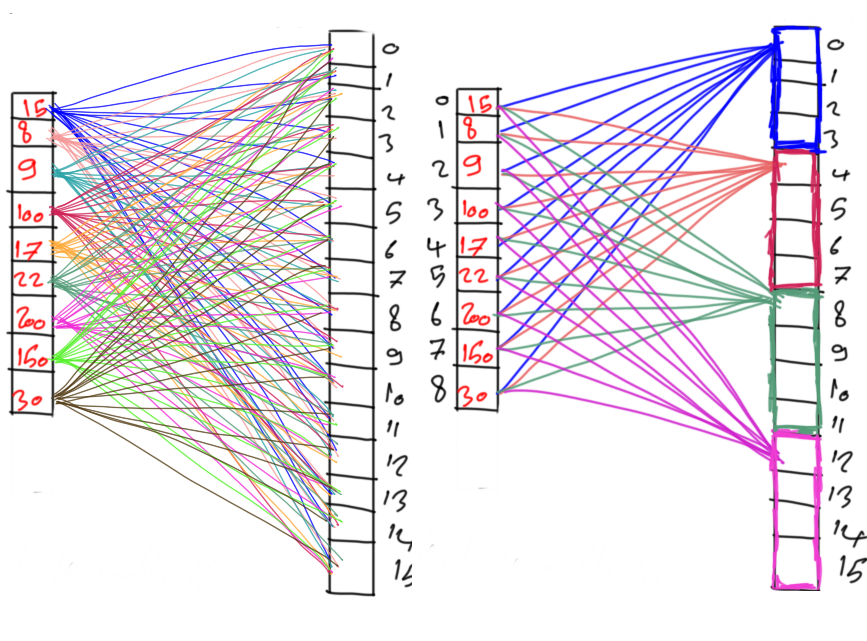](https://www.linkedin.com/pulse/derivation-convolutional-neural-network-from-fully-connected-gad)
## Book: Practical Computer Vision Applications Using Deep Learning with CNNs
You can also check my book cited as [**Ahmed Fawzy Gad 'Practical Computer Vision Applications Using Deep Learning with CNNs'. Dec. 2018, Apress, 978-1-4842-4167-7**](https://www.amazon.com/Practical-Computer-Vision-Applications-Learning/dp/1484241665) which discusses neural networks, convolutional neural networks, deep learning, genetic algorithm, and more.
Find the book at these links:
- [Amazon](https://www.amazon.com/Practical-Computer-Vision-Applications-Learning/dp/1484241665)
- [Springer](https://link.springer.com/book/10.1007/978-1-4842-4167-7)
- [Apress](https://www.apress.com/gp/book/9781484241660)
- [O'Reilly](https://www.oreilly.com/library/view/practical-computer-vision/9781484241677)
- [Google Books](https://books.google.com.eg/books?id=xLd9DwAAQBAJ)
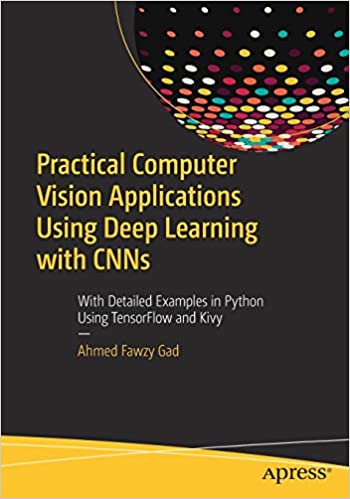
# Citing PyGAD - Bibtex Formatted Citation
If you used PyGAD, please consider adding a citation to the following paper about PyGAD:
```
@misc{gad2021pygad,
title={PyGAD: An Intuitive Genetic Algorithm Python Library},
author={Ahmed Fawzy Gad},
year={2021},
eprint={2106.06158},
archivePrefix={arXiv},
primaryClass={cs.NE}
}
```
# Contact Us
* E-mail: ahmed.f.gad@gmail.com
* [LinkedIn](https://www.linkedin.com/in/ahmedfgad)
* [Amazon Author Page](https://amazon.com/author/ahmedgad)
* [Heartbeat](https://heartbeat.fritz.ai/@ahmedfgad)
* [Paperspace](https://blog.paperspace.com/author/ahmed)
* [KDnuggets](https://kdnuggets.com/author/ahmed-gad)
* [TowardsDataScience](https://towardsdatascience.com/@ahmedfgad)
* [GitHub](https://github.com/ahmedfgad)